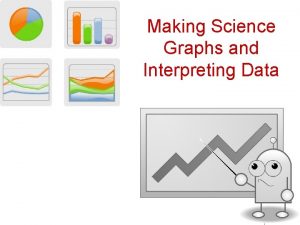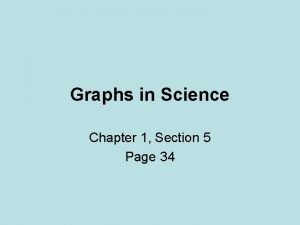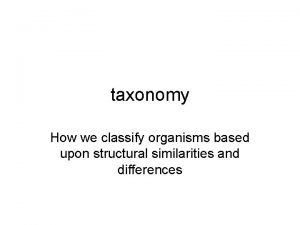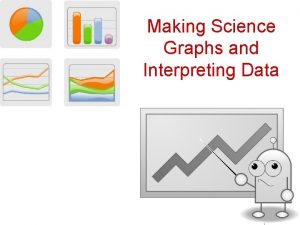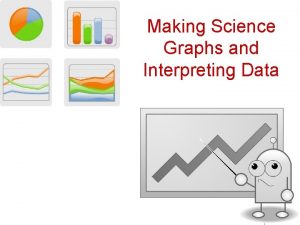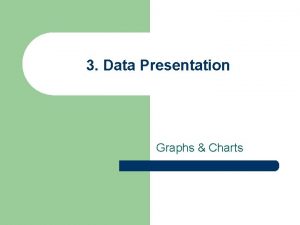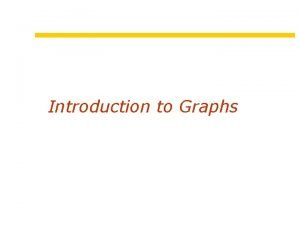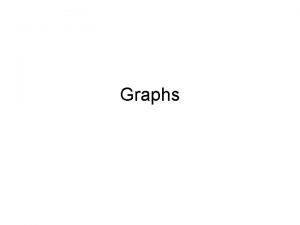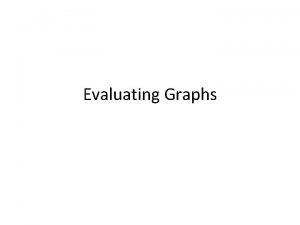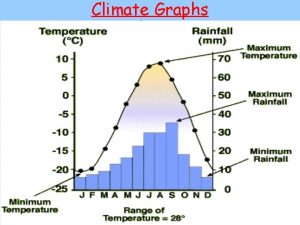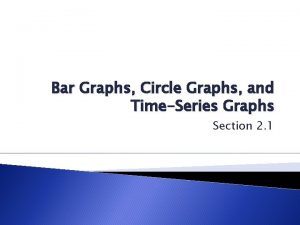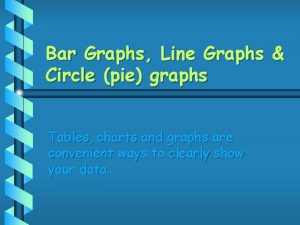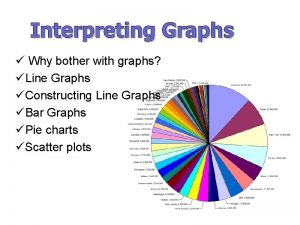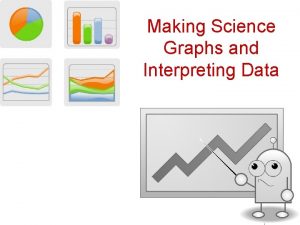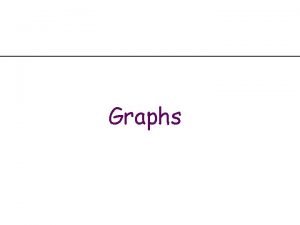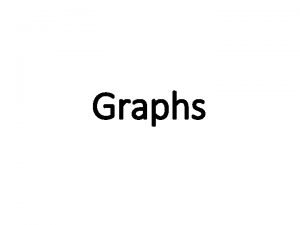DATA ANALYSIS IN SCIENCE Scientific Graphs Most scientific











































- Slides: 43

DATA ANALYSIS IN SCIENCE

Scientific Graphs � Most scientific graphs are made as line graphs. There may be times when other types would be appropriate, but they are rare. � The lines on scientific graphs are usually drawn either straight or curved.

Scientific Graphs � These "smoothed" lines do not have to touch all the data points, but they should at least get close to most of them. � They are called best-fit lines. � In general, scientific graphs are not drawn in connect-the-dot fashion.

Scientific Graphs � Two examples of best-fit graph lines are pictured below. One is drawn correctly; the other is not. Graph B Graph A � Which graph is correct? Graph B is correct because the line is closer to more data points.

Locating Points on a Graph Example � Use the graph above to answer the three questions for this problem. 1. Which point is on the y-axis? A 2. Which point is labeled (20, 60)? B 3. Which point(s) have a y-coordinate of 30? A

Initial Practice: Points on a Graph � Use the graph above to answer the three questions for this problem. 1. Which point is (0, 6)? R 2. What is the y-coordinate of point S? zero 3. What are the coordinates of point T? (1, 5)

Graphs � Graphs are a useful tool in science. � The visual characteristics of a graph make trends in data easy to see. � One of the most valuable uses for graphs is to "predict" data that is not measured on the graph.

Graphs � Extrapolate: extending the graph, along the same slope, above or below measured data. � Interpolate: predicting data between two measured points on the graph.

How To Construct a Line Graph On Paper STEP 1 WHAT TO DO Identify the variables HOW TO DO IT a. Independent Variable (Controlled by the experimenter) · Goes on the X axis (horizontal) · Should be on the left side of a data table. b. Dependent Variable (Changes with the independent variable) · Goes on the Y axis (vertical) · Should be on the right side of a data table.

How To Construct a Line Graph On Paper STEP 2 WHAT TO DO HOW TO DO IT Determine the a. Subtract the lowest data value from the highest variable range data value. b. Do each variable separately.

How To Construct a Line Graph On Paper STEP 3 WHAT TO DO HOW TO DO IT Determine the a. Determine a scale, the numerical value for each scale of the square, that best fits the range of each variable. graph b. Spread the graph to use MOST of the available space.

How To Construct a Line Graph On Paper STEP 4 WHAT TO DO HOW TO DO IT · This tells what data the lines on your graph label each axis represent. Label both the x- and y-axis. Number and

How To Construct a Line Graph On Paper STEP WHAT TO DO 5 Plot the data points HOW TO DO IT a. Plot each data value on the graph with a dot. b. You can put the data number by the dot, if it does not clutter your graph.

How To Construct a Line Graph On Paper STEP WHAT TO DO 6 Draw the graph HOW TO DO IT a. Draw a curve or a line that best fits the data points. b. Most graphs of experimental data are not drawn as "connectthe-dots".

How To Construct a Line Graph On Paper STEP WHAT TO DO 7 HOW TO DO IT Title the graph a. Your title should clearly tell what the graph is about. b. If your graph has more than one set of data, provide a "key" to identify the different lines.

Graphing Practice – Problem 1 Age of the tree in years Average thickness of the Average thickness of annual rings in cm. the annual rings in cm. Forest A Forest B 10 2. 2 20 2. 2 2. 5 30 3. 5 3. 6 40 3. 8 50 4. 5 4. 0 60 4. 3 4. 5 The thickness of the annual rings indicates what type of environment was occurring at the time of its development. A thin ring usually indicates a lack of water, forest fires, or a major insect infestation. A thick ring indicates just the opposite.

Graphing Practice – Problem 1 Age of the tree in years Average thickness of the Average thickness of annual rings in cm. the annual rings in cm. Forest A Forest B 10 2. 2 20 2. 2 2. 5 30 3. 5 3. 6 40 3. 8 50 4. 5 4. 0 60 4. 3 4. 5 A. Make a line graph of the data.

1. 2. 3. 4. 5. 6. 7. Identify the variables (Independent variable is on left side of data table. ) Determine the range Determine the scale Number and label each axis Plot the points Draw the graph Title the graph & provide a “key” Blue = Forest A Red = Forest B 4. 5 Average thickness of annual rings (cm) Graphing Practice Problem 1 4. 0 3. 5 3. 0 2. 5 2. 0 1. 5 1. 0 0. 5 10 20 30 40 50 Age of the tree (years) 60

Graphing Practice – Problem 1 Age of the tree in years Average thickness of the Average thickness of annual rings in cm. the annual rings in cm. Forest A Forest B 10 2. 2 20 2. 2 2. 5 30 3. 5 3. 6 40 3. 8 50 4. 5 4. 0 60 4. 3 4. 5 B. Make a key for the different forests being graphed. Blue = Forest A Red = Forest B

Graphing Practice – Problem 1 Age of the tree in years Average thickness of the Average thickness of annual rings in cm. the annual rings in cm. Forest A Forest B 10 2. 2 20 2. 2 2. 5 30 3. 5 3. 6 40 3. 8 50 4. 5 4. 0 60 4. 3 4. 5 C. What is the dependent variable? average thickness of the annual rings

Graphing Practice – Problem 1 Age of the tree in years Average thickness of the Average thickness of annual rings in cm. the annual rings in cm. Forest A Forest B 10 2. 2 20 2. 2 2. 5 30 3. 5 3. 6 40 3. 8 50 4. 5 4. 0 60 4. 3 4. 5 D. What is the independent variable? Age of the trees

Graphing Practice – Problem 1 Age of the tree in years Average thickness of the Average thickness of annual rings in cm. the annual rings in cm. Forest A Forest B 10 2. 2 20 2. 2 2. 5 30 3. 5 3. 6 40 3. 8 50 4. 5 4. 0 60 4. 3 4. 5 E. What was the average thickness of the annual rings of 40 year old trees in Forest A? 3. 0 cm

Graphing Practice – Problem 1 Age of the tree in years Average thickness of the Average thickness of annual rings in cm. the annual rings in cm. Forest A Forest B 10 2. 2 20 2. 2 2. 5 30 3. 5 3. 6 40 3. 8 50 4. 5 4. 0 60 4. 3 4. 5 E. What was the average thickness of the annual rings of 40 year old trees in Forest B? 3. 8 cm

Graphing Practice – Problem 2 p. H of water Number of tadpoles 8. 0 45 7. 5 69 7. 0 78 6. 5 88 6. 0 43 5. 5 23 A. Make a line graph of the data.

Graphing Practice Problem 2 2. 3. 4. 5. 6. 7. Identify the variables (Independent variable is on left side of data table. ) Determine the range Determine the scale Number and label each axis Plot the points Draw the graph Title the graph & provide a “key” 80 Number of tadpoles 1. 90 70 60 50 40 30 20 10 5 5. 5 6 6. 5 7 p. H of water 7. 5 8

Graphing Practice – Problem 2 p. H of water Number of tadpoles 8. 0 45 7. 5 69 7. 0 78 6. 5 88 6. 0 43 5. 5 23 B. What is the dependent variable? Number of tadpoles

Graphing Practice – Problem 2 p. H of water Number of tadpoles 8. 0 45 7. 5 69 7. 0 78 6. 5 88 6. 0 43 5. 5 23 C. What is the independent variable? p. H of water

Graphing Practice – Problem 2 p. H of water Number of tadpoles 8. 0 45 7. 5 69 7. 0 78 6. 5 88 6. 0 43 5. 5 23 D. What is the average number of tadpoles collected per sample? 58

Graphing Practice – Problem 2 p. H of water Number of tadpoles 8. 0 45 7. 5 69 7. 0 78 6. 5 88 6. 0 43 5. 5 23 E. What is the optimum water p. H for tadpole development? 6. 5

Graphing Practice – Problem 2 p. H of water Number of tadpoles 8. 0 45 7. 5 69 7. 0 78 6. 5 88 6. 0 43 5. 5 23 F. Between what two p. H readings is there the greatest change in tadpole number? 5. 5 and 6. 5

Graphing Practice – Problem 2 p. H of water Number of tadpoles 8. 0 45 7. 5 69 7. 0 78 6. 5 88 6. 0 43 5. 5 23 G. How many tadpoles would we expect to find in water with a p. H reading of 5. 0? zero

Graphing Practice – Problem 3 Amount of Wine sap Apples: Golden Apples: Gala Apples: ethylene in ml/m 2 Days to Maturity 10 14 14 15 15 12 12 13 20 11 9 10 25 10 7 9 30 8 7 8 35 8 7 7 Ethylene is a plant hormone that causes fruit to mature. The data above concerns the amount of time it takes for fruit to mature from the time of the first application of ethylene by spraying a field of trees.

Graphing Practice – Problem 3 Amount of Wine sap Apples: Golden Apples: Gala Apples: ethylene in ml/m 2 Days to Maturity 10 14 14 15 15 12 12 13 20 11 9 10 25 10 7 9 30 8 7 8 35 8 7 7 A. Make a line graph of the data.

Graphing Practice Problem 3 Days to maturity (days) Red = Wine sap apples Green = Golden apples Blue = Gala apples 16 14 12 10 8 6 4 2 5 10 15 20 25 30 Amount of ethylene (m. L/m 2) 35

Graphing Practice – Problem 3 Amount of Wine sap Apples: Golden Apples: Gala Apples: ethylene in ml/m 2 Days to Maturity 10 14 14 15 15 12 12 13 20 11 9 10 25 10 7 9 30 8 7 8 35 8 7 7 B. Make a key for the different kinds of apples being graphed. Red = Wine sap apples Green = Golden apples Blue = Gala apples

Graphing Practice – Problem 3 Amount of Wine sap Apples: Golden Apples: Gala Apples: ethylene in ml/m 2 Days to Maturity 10 14 14 15 15 12 12 13 20 11 9 10 25 10 7 9 30 8 7 8 35 8 7 7 C. What is the dependent variable? Days to maturity

Graphing Practice – Problem 3 Amount of Wine sap Apples: Golden Apples: Gala Apples: ethylene in ml/m 2 Days to Maturity 10 14 14 15 15 12 12 13 20 11 9 10 25 10 7 9 30 8 7 8 35 8 7 7 D. What is the independent variable? Amount of ethylene

Graphing Practice – Problem 4 Water Temperature in ºC Number of developing clams 15 75 20 90 25 120 30 140 35 75 40 40 45 15 50 0 A clam farmer has been keeping records of the water temperature and the number of clams developing from fertilized eggs. The data is recorded above.

Graphing Practice – Problem 4 Water Temperature in ºC Number of developing clams 15 75 20 90 25 120 30 140 35 75 40 40 45 15 50 0 A. Make a line graph of the data.

Graphing Practice Problem 4 150 135 120 Number of developing clams 105 90 75 60 45 30 15 10 20 30 40 50 Water temperature (°C)

Graphing Practice – Problem 4 Water Temperature in ºC Number of developing clams 15 75 20 90 25 120 30 140 35 75 40 40 45 15 50 0 B. What is the dependent variable? Number of developing clams

Graphing Practice – Problem 4 Water Temperature in ºC Number of developing clams 15 75 20 90 25 120 30 140 35 75 40 40 45 15 50 0 C. What is the independent variable? Water temperature

Graphing Practice – Problem 4 Water Temperature in ºC Number of developing clams 15 75 20 90 25 120 30 140 35 75 40 40 45 15 50 0 D. What is the optimum temperature for clam development? 30°C
 Interpreting graphs science
Interpreting graphs science Testability tips in state graphs
Testability tips in state graphs Speed and velocity
Speed and velocity Graphs that enlighten and graphs that deceive
Graphs that enlighten and graphs that deceive End behavior of polynomials
End behavior of polynomials My subject is
My subject is Why are line graphs powerful tools in science
Why are line graphs powerful tools in science Why are line graphs powerful tools in science
Why are line graphs powerful tools in science The nature of science chapter 1 section 3 answer key
The nature of science chapter 1 section 3 answer key Automated generation and analysis of attack graphs
Automated generation and analysis of attack graphs Displaying quantitative data with graphs
Displaying quantitative data with graphs Scatter plot bivariate data
Scatter plot bivariate data Displaying quantitative data with graphs
Displaying quantitative data with graphs Data tables and graphs
Data tables and graphs Scientific inquiry vs scientific method
Scientific inquiry vs scientific method How is a scientific law different from a scientific theory?
How is a scientific law different from a scientific theory? Data quality is always a concern with secondary data
Data quality is always a concern with secondary data Research procedure in methodology
Research procedure in methodology Data preparation and basic data analysis
Data preparation and basic data analysis Data acquisition and data analysis
Data acquisition and data analysis Most general to most specific classification
Most general to most specific classification Most general to most specific classification
Most general to most specific classification In the name of allah most gracious most merciful
In the name of allah most gracious most merciful In the name of allah the most beneficent the most merciful
In the name of allah the most beneficent the most merciful Beneficent pronunciation
Beneficent pronunciation Guddi baji
Guddi baji Most general to most specific classification
Most general to most specific classification The arrangement chapter 9
The arrangement chapter 9 In the name of god most gracious most merciful
In the name of god most gracious most merciful In the name of allah the most gracious the most merciful
In the name of allah the most gracious the most merciful In the name of allah, the beneficent, the merciful
In the name of allah, the beneficent, the merciful In the name of god most gracious most merciful
In the name of god most gracious most merciful Aqidah
Aqidah In the name of god most gracious prayer
In the name of god most gracious prayer Allah the most beneficent
Allah the most beneficent Science buddies scientific method
Science buddies scientific method 6 manipulative skills
6 manipulative skills Scientific methods in computer science
Scientific methods in computer science K h d m d c m chart
K h d m d c m chart The science of scientific writing
The science of scientific writing Natural vs social science
Natural vs social science 3 branches of natural science
3 branches of natural science Natural science vs physical science
Natural science vs physical science Applied science vs pure science
Applied science vs pure science
